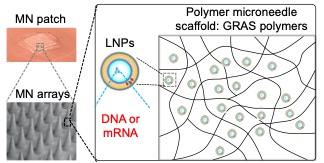Vaccination Delivery
SARS-CoV-2 Vaccination Delivery System
Microneedle Injection of SARS-CoV-2 DNA Fragment
With the spread of SARS-CoV-2 continuing, the need for a solution to halt this deadly disease is becoming more pertinent. The most likely solution is a vaccine that will infer resistance to the virus. Unfortunately, vaccines need to be injected, which will require millions of persons to flood hospitals, urgent care, and primary care offices to receive the vaccination. In addition, vaccines typically have a limited shelf life and need to be stored and transported at cold temperatures to maintain their effectiveness. All of these factors make the distribution and implementation of a vaccine challenging. Researchers at Virginia Commonwealth University (VCU) have devised a technology which would mitigate most if not all of these issues.
The technology
The unique microneedle design utilized by the researchers at VCU combines materials already considered safe by the FDA into a self-deployable patch. The patch is comprised of a biocompatible polymer microneedle (MN) scaffold that is then coated with a hydrogel-forming layer. This hydrogel contains lipid nanoparticles (LNPs) that encapsulate DNA or mRNA encoding for a portion of the SARS-CoV-2 virus. The entire composition can be seen in the figure below. The LNP loaded MN patches can then be dried stabilizing the LNPs containing DNA or an mRNA fragment. By stabilizing the LNPs the need for cold chain transportation and the limited shelf-life are resolved. The patches, which are applied similar to a Band- Aid, can then be delivered directly via mail or be picked up from a set location to then be self-administered by the patients, limiting the strain on the medical system to administer the vaccine. Upon administration, the LNPs are reconstituted and maintain high transfection efficiency allowing an immune response to be activated.

Figure 1. Self-deployable MN patches that deliver DNA/mRNA vaccines for SARS- CoV-2. Left: a prototype (top) and an SEM image (bottom) of a MN patch. Middle: MNs are composed of mechanically strong polymer cores and a hydrogel-forming coating. The hydrogel-forming coating is composed of (1) polymer scaffold and (2) DNA/mRNA-loaded LNPs (right) that are encapsulated in the micropores of hydrogel.
